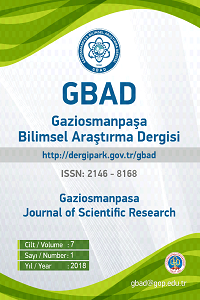Beyaz Peynirden Bakteriyosin Üreten Bakterinin (Enterococcus faecium) İzolasyonu ve Bakteriyosinin Karakterizayonu
Bu çalışmada, yöresel bir peynirden izole edilen bakteri ve bu bakterinin ürettiği antimikrobiyal bileşik karakterize edilmiştir. İzole edilen bakteri, genel mikrobiyolojik analizler, karbonhidrat fermantasyonu ve yağ asidi profili testleri sonucunda Enterococcus faecium BP olarak tanımlanmıştır. Antimikrobiyal bileşiğin antimikrobiyal spektrumu belirlenmiş ve inhibitör aktivitesi üzerine bazı enzimlerin, organik çözücülerin, ısıl işlemin, depolama koşullarının ve üretici bakterinin gelişim fazının etkileri araştırılmıştır. İzole edilen bakterinin Gram-pozitif, kok şeklinde, hareketsiz, hemoliz, katalaz, Voges-Praskauer ve endospor negatif olduğu, % 3,0-6,5 NaCl içeren besi ortamında, pH 4,0-9,6 ve 10-45°C aralığında gelişebildiği tespit edilmiştir. Karbonhidrat fermantasyonu ve yağ asidi profili analizleri bakterinin Enterococcus faecium olduğunu ortaya koymuştur. Antimikrobiyal bileşiğin papain, tripsin, pankreatin ve proteaz enzimlerine duyarlı, ancak katalaz, lipaz ve amilaz enzimlerine, etil alkol, metanol, etil eter, kloroform, hekzan gibi çözücülere karşı dayanıklı olduğu saptanmıştır. Bu sonuçlar, bileşiğin bir bakteriyosin olduğunu ortaya koymuştur. Bakteriyosinin oldukça geniş bir pH aralığında (2-10) aktivitesini koruduğu, yüksek derecede uygulanan ısıl işlem (80°C’de 30 dakika) ve farklı koşullarda gerçekleştirilen depolama (4, -18 ve -85ºC) süresince aktivitesini muhafaza ettiği gözlenmiştir. Antimikrobiyal bileşik, test edilen bazı Lactobacillus, Lactococcus, Listeria, Bacillus, Campylobacter ve Citrobacter türlerine karşı da inhibitör etki göstermiştir. Bakteriyosinin 37°C’de MRS besiyerinde ve bakterinin logaritmik fazın sonu ile sabit fazın başında maksimum düzeyde üretildiği tespit edilmiştir
Isolation of Bacteriocin Producing Bacterium (Enterococcus faecium) From White Cheese and Characterization of its Bacteriocin
In this study, a bacterium isolated from a traditional cheese and the inhibitory compound produced by this bacteria were characterized. The isolated bacterium was identified as Enterococcus faecium BP by using general microbiological analysis, carbohydrate fermentation and fatty acid profile identification test systems. The effects of enzymes, organic solvents, heat treatment, storage conditions and the growth phase of the bacterium on the inhibitory activity of the compound, and its antimicrobialspectrum were determined. The isolated bacterium was Gram positive, coccus, non-motile, hemolyse, catalase, Voges-Praskauer and endospor negative and able to grow in the presence of 3.0-6.5 % NaCl, and at pH 4.0 to 9.6 and 10 to 45°C. Carbohydrate fermentation and fatty acid profile identification systems showed that this bacterium was Enterococcus faecium. It was found that the antimicrobial compound was sensitive to papain, tripsin, pancretaine and protease, but resistant to catalase, lipase and amylase enzymes, ethanol, methanol, ethyl ether, chloroform and hexane. These results indicated that this compound is a bacteriocin. It was observed that bacteriocin maintained its activity in a wide pH range (2-10), and after high heat treatment (80°C/30 min) and during various storage conditions (4, -18 and -85ºC). The antimicrobial compound has inhibitor activity against Lactobacillus, Lactococcus, Leuconostoc, Staphylococcus, Listeria, Bacillus, Campylobacter and Citrobacter species tested too. It was determined that bacteriocin was produced at maximum level during the late logarithmic phase and at the beginning of stationary phase of the bacterium in MRS broth and at 37°C
